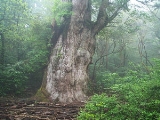
Cryptomeria
Encyclopedia
Cryptomeria is a monotypic genus
of conifer
in the cypress
family Cupressaceae
formerly belonging to the family Taxodiaceae
; it includes only one species
, Cryptomeria japonica (syn.: Cupressus japonica L.f.). It is endemic to Japan
, where it is known as Sugi . The tree is often called Japanese Cedar in English, though the tree is not related to the cedars (Cedrus). In Darjeeling district and Sikkim in India, where it is one of the most widely growing trees, Cryptomeria japonica is called Dhuppi and is favoured for its light wood, extensively used in house building.
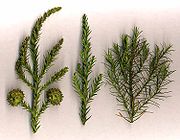

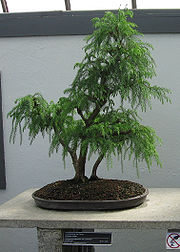
tree
, reaching up to 70 m (229.7 ft) tall and 4 m (13.1 ft) trunk diameter, with red-brown bark which peels in vertical strips. The leaves
are arranged spirally, needle-like, 0.5–1 cm (0.196850393700787–0.393700787401575 in) long; and the seed
cones globular, 1–2 cm (0.393700787401575–0.78740157480315 in) diameter with about 20–40 scales. It is superficially similar to the related Giant Sequoia
(Sequoiadendron giganteum), from which it can be differentiated by the longer leaves (under 0.5 cm in the Giant Sequoia) and smaller cones (4–6 cm in the Giant Sequoia), and the harder bark on the trunk (thick, soft and spongy in Giant Sequoia).
Sugi (and Hinoki
) pollen is a major cause of hay fever in Japan.
Sugi has been so long-cultivated in China
that it is thought by some to be native there. Forms selected for ornament and timber production long ago in China have been described as a distinct variety Cryptomeria japonica var. sinensis (or even a distinct species, Cryptomeria fortunei), but they do not differ from the full range of variation found in the wild in Japan, and there is no definite evidence the species ever occurred wild in China.
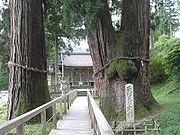
 Sugi is the national tree
Sugi is the national tree
of Japan, commonly planted around temple
s and shrines, with many hugely impressive trees planted centuries ago. Sargent (1894; The Forest Flora of Japan) recorded the instance of a daimyō
(feudal lord) who was too poor to donate a stone lantern at the funeral of the Shogun
Tokugawa Ieyasu
(1543–1616) at Nikkō Tōshō-gū
, but requested instead to be allowed to plant an avenue of Sugi, "that future visitors might be protected from the heat of the sun". The offer was accepted; the avenue, which still exists, is over 65 km (40.4 mi) long, and "has not its equal in stately grandeur".
It is also extensively used in forestry
plantation
s in Japan, China and the Azores
islands, and is widely cultivated as an ornamental tree in other temperate areas, including Britain, Europe, North America and eastern Himalaya regions of Nepal and India.
One very popular ornamental form is the cultivar
"Elegans", which is notable for retaining juvenile foliage throughout its life, instead of developing normal adult foliage when one year old (see the picture with different shoots). It makes a small, shrub
by tree 5–10m tall. There are numerous dwarf cultivars that are widely used in rock gardens and for bonsai, including 'tansu', 'koshyi', 'little diamond', 'yokohama' and 'kilmacurragh.'
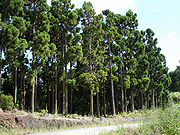 The wood is scented, reddish-pink in colour, lightweight but strong, waterproof and resistant to decay. It is favoured in Japan for all types of construction work as well as interior panelling
The wood is scented, reddish-pink in colour, lightweight but strong, waterproof and resistant to decay. It is favoured in Japan for all types of construction work as well as interior panelling
, etc.
Cryptomeria is used as a food plant by the larva
e of some moth
s of the genus Endoclita
including E. auratus, E. punctimargo and E. undulifer.
Its introduction in the Azores
islands to be used commercially, resulted in the destruction of much of the original, now threatened, native laurel
forest which affected an entire complex environment threatening many other species such as the priolo
.
Genus
In biology, a genus is a low-level taxonomic rank used in the biological classification of living and fossil organisms, which is an example of definition by genus and differentia...
of conifer
Pinophyta
The conifers, division Pinophyta, also known as division Coniferophyta or Coniferae, are one of 13 or 14 division level taxa within the Kingdom Plantae. Pinophytes are gymnosperms. They are cone-bearing seed plants with vascular tissue; all extant conifers are woody plants, the great majority being...
in the cypress
Cupressaceae
The Cupressaceae or cypress family is a conifer family with worldwide distribution. The family includes 27 to 30 genera , which include the junipers and redwoods, with about 130-140 species in total. They are monoecious, subdioecious or dioecious trees and shrubs from 1-116 m tall...
family Cupressaceae
Cupressaceae
The Cupressaceae or cypress family is a conifer family with worldwide distribution. The family includes 27 to 30 genera , which include the junipers and redwoods, with about 130-140 species in total. They are monoecious, subdioecious or dioecious trees and shrubs from 1-116 m tall...
formerly belonging to the family Taxodiaceae
Taxodiaceae
The Taxodiaceae were at one time regarded as a distinct plant family comprising the following ten genera of coniferous trees:*Athrotaxis*Cryptomeria*Cunninghamia*†Cunninghamites*Glyptostrobus*Metasequoia*Sciadopitys...
; it includes only one species
Species
In biology, a species is one of the basic units of biological classification and a taxonomic rank. A species is often defined as a group of organisms capable of interbreeding and producing fertile offspring. While in many cases this definition is adequate, more precise or differing measures are...
, Cryptomeria japonica (syn.: Cupressus japonica L.f.). It is endemic to Japan
Japan
Japan is an island nation in East Asia. Located in the Pacific Ocean, it lies to the east of the Sea of Japan, China, North Korea, South Korea and Russia, stretching from the Sea of Okhotsk in the north to the East China Sea and Taiwan in the south...
, where it is known as Sugi . The tree is often called Japanese Cedar in English, though the tree is not related to the cedars (Cedrus). In Darjeeling district and Sikkim in India, where it is one of the most widely growing trees, Cryptomeria japonica is called Dhuppi and is favoured for its light wood, extensively used in house building.



Description
It is a very large evergreenEvergreen
In botany, an evergreen plant is a plant that has leaves in all seasons. This contrasts with deciduous plants, which completely lose their foliage during the winter or dry season.There are many different kinds of evergreen plants, both trees and shrubs...
tree
Tree
A tree is a perennial woody plant. It is most often defined as a woody plant that has many secondary branches supported clear of the ground on a single main stem or trunk with clear apical dominance. A minimum height specification at maturity is cited by some authors, varying from 3 m to...
, reaching up to 70 m (229.7 ft) tall and 4 m (13.1 ft) trunk diameter, with red-brown bark which peels in vertical strips. The leaves
Leaf
A leaf is an organ of a vascular plant, as defined in botanical terms, and in particular in plant morphology. Foliage is a mass noun that refers to leaves as a feature of plants....
are arranged spirally, needle-like, 0.5–1 cm (0.196850393700787–0.393700787401575 in) long; and the seed
Seed
A seed is a small embryonic plant enclosed in a covering called the seed coat, usually with some stored food. It is the product of the ripened ovule of gymnosperm and angiosperm plants which occurs after fertilization and some growth within the mother plant...
cones globular, 1–2 cm (0.393700787401575–0.78740157480315 in) diameter with about 20–40 scales. It is superficially similar to the related Giant Sequoia
Sequoiadendron
Sequoiadendron giganteum is the sole living species in the genus Sequoiadendron, and one of three species of coniferous trees known as redwoods, classified in the family Cupressaceae in the subfamily Sequoioideae, together with Sequoia sempervirens and...
(Sequoiadendron giganteum), from which it can be differentiated by the longer leaves (under 0.5 cm in the Giant Sequoia) and smaller cones (4–6 cm in the Giant Sequoia), and the harder bark on the trunk (thick, soft and spongy in Giant Sequoia).
Sugi (and Hinoki
Chamaecyparis obtusa
Chamaecyparis obtusa is a species of cypress native to central Japan.It is a slow-growing tree which grows to 35 m tall with a trunk up to 1 m in diameter. The bark is dark red-brown...
) pollen is a major cause of hay fever in Japan.
Sugi has been so long-cultivated in China
China
Chinese civilization may refer to:* China for more general discussion of the country.* Chinese culture* Greater China, the transnational community of ethnic Chinese.* History of China* Sinosphere, the area historically affected by Chinese culture...
that it is thought by some to be native there. Forms selected for ornament and timber production long ago in China have been described as a distinct variety Cryptomeria japonica var. sinensis (or even a distinct species, Cryptomeria fortunei), but they do not differ from the full range of variation found in the wild in Japan, and there is no definite evidence the species ever occurred wild in China.
Symbolism and uses


National emblem
A national emblem symbolically represents a nation. Most national emblems originate in the natural world, such as animals or birds, but another object may serve. National emblems may appear on many things such as the national flag, coat of arms, or other patriotic materials...
of Japan, commonly planted around temple
Temple
A temple is a structure reserved for religious or spiritual activities, such as prayer and sacrifice, or analogous rites. A templum constituted a sacred precinct as defined by a priest, or augur. It has the same root as the word "template," a plan in preparation of the building that was marked out...
s and shrines, with many hugely impressive trees planted centuries ago. Sargent (1894; The Forest Flora of Japan) recorded the instance of a daimyō
Daimyo
is a generic term referring to the powerful territorial lords in pre-modern Japan who ruled most of the country from their vast, hereditary land holdings...
(feudal lord) who was too poor to donate a stone lantern at the funeral of the Shogun
Shogun
A was one of the hereditary military dictators of Japan from 1192 to 1867. In this period, the shoguns, or their shikken regents , were the de facto rulers of Japan though they were nominally appointed by the emperor...
Tokugawa Ieyasu
Tokugawa Ieyasu
was the founder and first shogun of the Tokugawa shogunate of Japan , which ruled from the Battle of Sekigahara in 1600 until the Meiji Restoration in 1868. Ieyasu seized power in 1600, received appointment as shogun in 1603, abdicated from office in 1605, but...
(1543–1616) at Nikkō Tōshō-gū
Nikko Tosho-gu
is a Shinto shrine located in Nikkō, Tochigi Prefecture, Japan. It is part of the "Shrines and Temples of Nikkō", a UNESCO World Heritage Site.Tōshō-gū is dedicated to Tokugawa Ieyasu, the founder of the Tokugawa shogunate. Initially built in 1617, during the Edo period, while Ieyasu's son Hidetada...
, but requested instead to be allowed to plant an avenue of Sugi, "that future visitors might be protected from the heat of the sun". The offer was accepted; the avenue, which still exists, is over 65 km (40.4 mi) long, and "has not its equal in stately grandeur".
It is also extensively used in forestry
Forestry
Forestry is the interdisciplinary profession embracing the science, art, and craft of creating, managing, using, and conserving forests and associated resources in a sustainable manner to meet desired goals, needs, and values for human benefit. Forestry is practiced in plantations and natural stands...
plantation
Plantation
A plantation is a long artificially established forest, farm or estate, where crops are grown for sale, often in distant markets rather than for local on-site consumption...
s in Japan, China and the Azores
Azores
The Archipelago of the Azores is composed of nine volcanic islands situated in the middle of the North Atlantic Ocean, and is located about west from Lisbon and about east from the east coast of North America. The islands, and their economic exclusion zone, form the Autonomous Region of the...
islands, and is widely cultivated as an ornamental tree in other temperate areas, including Britain, Europe, North America and eastern Himalaya regions of Nepal and India.
One very popular ornamental form is the cultivar
Cultivar
A cultivar'Cultivar has two meanings as explained under Formal definition. When used in reference to a taxon, the word does not apply to an individual plant but to all those plants sharing the unique characteristics that define the cultivar. is a plant or group of plants selected for desirable...
"Elegans", which is notable for retaining juvenile foliage throughout its life, instead of developing normal adult foliage when one year old (see the picture with different shoots). It makes a small, shrub
Shrub
A shrub or bush is distinguished from a tree by its multiple stems and shorter height, usually under 5–6 m tall. A large number of plants may become either shrubs or trees, depending on the growing conditions they experience...
by tree 5–10m tall. There are numerous dwarf cultivars that are widely used in rock gardens and for bonsai, including 'tansu', 'koshyi', 'little diamond', 'yokohama' and 'kilmacurragh.'

Panelling
Panelling is a wall covering constructed from rigid or semi-rigid components. These are traditionally interlocking wood, but could be plastic or other materials....
, etc.
Cryptomeria is used as a food plant by the larva
Larva
A larva is a distinct juvenile form many animals undergo before metamorphosis into adults. Animals with indirect development such as insects, amphibians, or cnidarians typically have a larval phase of their life cycle...
e of some moth
Moth
A moth is an insect closely related to the butterfly, both being of the order Lepidoptera. Moths form the majority of this order; there are thought to be 150,000 to 250,000 different species of moth , with thousands of species yet to be described...
s of the genus Endoclita
Endoclita
Endoclita is a genus of moths of the family Hepialidae. There are 60 described species found in eastern and southeast Asia and the Indian subcontinent.- Species :*E. aboe - India*E. absurdus - China*E. actinidae - China...
including E. auratus, E. punctimargo and E. undulifer.
Its introduction in the Azores
Azores
The Archipelago of the Azores is composed of nine volcanic islands situated in the middle of the North Atlantic Ocean, and is located about west from Lisbon and about east from the east coast of North America. The islands, and their economic exclusion zone, form the Autonomous Region of the...
islands to be used commercially, resulted in the destruction of much of the original, now threatened, native laurel
Laurisilva
Laurisilva or laurissilva is a subtropical forest, found in areas with high humidity and relatively stable and mild temperatures. They are characterised by evergreen, glossy-leaved tree species that look alike with leaves of lauroide type...
forest which affected an entire complex environment threatening many other species such as the priolo
Azores Bullfinch
The Azores Bullfinch , also known as the São Miguel Bullfinch, or locally in Portuguese as the Priolo, is an endangered passerine bird in the true finch family...
.
External links
- USDA ARS Germplasm Resources Information Network
- USDA NRCS Plants Database
- http://www.cirrusimage.com/tree_Japanese_cedar.htmCryptomeria japonica, Morton ArboretumMorton ArboretumThe Morton Arboretum, in Lisle, Illinois, covers 1,700 acres and is made up of gardens of various plant types and collections of trees from specific taxonomical and geographical areas. It includes native woodlands and a restored Illinois prairie. The Arboretum has over 4,100 different species of...
acc. 560-82*11 & 12] - USDA Forest Service Fact Sheet ST-219 Japanese Cedar (pdf)

